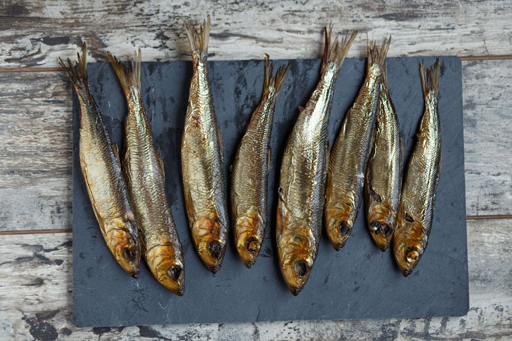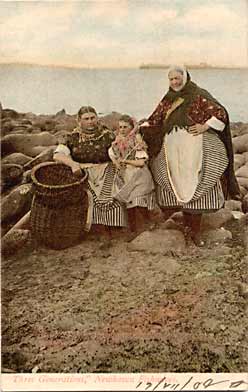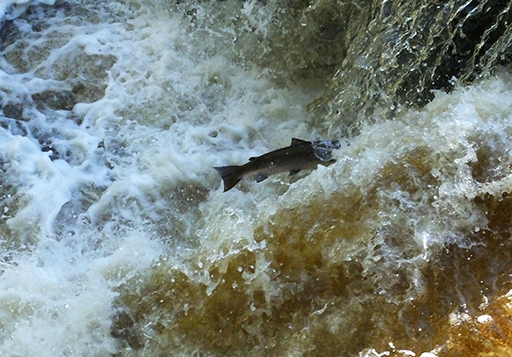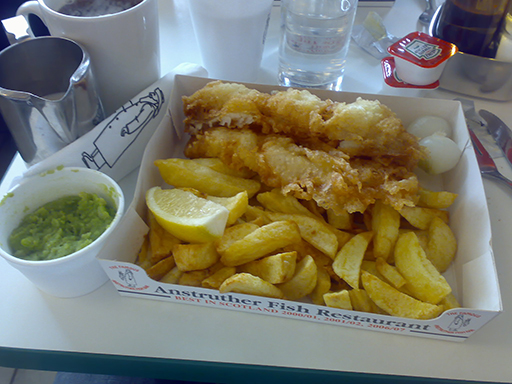6.5 Herrin, caller an saut: herring, fresh and salt

For centuries, herrings, both fresh and salted, were a staple food of Scotland. The growth of the herring industry in north-east Scotland in the 18th century is described by Neil Gunn in his novel The Silver Darlings. Here an extract:
Beginning in May, shoals of herring followed their migratory routes from Stornoway round the north coast, then south to Yarmouth. The catch was landed at the nearest port to be met by an army of merchants, curers and itinerant fisher lasses who gutted the fish and packed it in salt in barrels, for export to Europe and Russia. At the peak of the herring industry in 1907, 2,500,000 barrels ( 250,000 tons) were cured and exported.
Activity 12
As the extract from Gunn’s book states, the peak of herring fishing was reached in 1907. Since then this industry has seen a steady decline. Read the text about Overfishing [Tip: hold Ctrl and click a link to open it in a new tab. (Hide tip)] on HistoryShelf to find out more about the decline of herring fishing in Scotland and note down three important factors in this decline.
Answer
This is a model answer. Your answer might be different.
- Overfishing began in the 1920s which continued for almost 50 years until the stocks were so drastically low that a fishing ban was imposed that lasted for 4 years.
- Markets for cured herring declined as standards of living rose.
- Scotland/the UK joining the European Common Market in 1972 meant that fishing fleets from other nations were entitled to their share of the fish in ‘Scottish’ waters
- Fishing quotas were introduced in the 1970s

Following the decline of the herring fishing, many fishermen turned to catching shellfish, including fresh oysters. While shellfish were in the recent past considered as worthless, they have been a source of food since prehistoric times.
Archaeologists have discovered many Scottish middens (household rubbish dumps) with large quantities of shells buried in them, some dating back to the Stone Age.

In the 18th century, oysters were a popular food and ‘caller ou’ (fresh oysters) was the cry of the oyster wives as they stood at their stances on Edinburgh streets. Oysters are in season in those months which have an R in them, unlike herring which are in season in the months of May, June, July and August.
They were so popular in Edinburgh that the main taverns in the city were called Oyster taverns. Musselburgh on the Firth of Forth owes its name to the rich shoals of mussels at the mouth of the River Esk. Today, most of the langoustines you see in Spain have been exported from Scotland: Scottish lobsters are exported to Europe and China.
Activity 13
The poet Robert Fergusson (1750-1774) wrote his poem ‘Caller Oysters’ in praise of oysters, celebrating this particular seafood with immense enthusiasm and hyperbole. Not only does he praise their culinary qualities, his hyperbole extends to their alleged medicinal qualities as well.
Listen to the beginning of this poem and try to understand its words. Again, use this as an opportunity to practice your spoken Scots by reading this verse out loud and comparing your version with our model. Finally, read the transcript with our translation.
Transcript
Listen
| Come prie, frail man! For gin thou art sick The oyster is a rare cathartic, As ever doctor patient gart lick To cure his ails; Whether you hae the head or heartache, It ay prevails | Come taste, frail man! For if you are sick The oyster is a great purgative As ever a doctor gave a patient to lick To cure his ails Whether you have the head or heartache It always prevails |
Model
| Come prie, frail man! For gin thou art sick The oyster is a rare cathartic, As ever doctor patient gart lick To cure his ails; Whether you hae the head or heartache, It ay prevails | Come taste, frail man! For if you are sick The oyster is a great purgative As ever a doctor gave a patient to lick To cure his ails Whether you have the head or heartache It always prevails |

Wild salmon used to be so abundant in our Scottish rivers that it was considered a peasant food and farmhands complained that they were fed so much of it. Atlantic salmon begins life in the rivers of countries bordering the North Atlantic. They migrate to the sea as adults then return, after one to four years, to their native rivers to spawn and produce a new generation.
Our rivers have been so over-fished that most of the salmon we eat now is produced in fish farms. Nevertheless, in 2014, it beat confectionery to become the UK's biggest food export.

When you are in Scotland, you will hear people talking about having a cairry-oot (also carryout, cerry-oot, carry out, kerry oot, cairy oot) for dinner. This word describes food or alcoholic drink bought in a restaurant, pub, etc. for consumption elsewhere.
And a fish supper is considered by many as Scotland’s most popular take-away food or cairry-oot. It traditionally consists of deep-fried potato chips and haddock; the supper is often wrapped in layers of (news)paper to keep it warm: usually eaten with the fingers – though today a box of some sort and plastic fork is now common.
A recipe in Scots 

And to finish the food and drink unit, here is a fun activity that will hopefully encourage you to get cooking. This time it is another iconic Scottish dish… Cullen Skink. This soup is a local speciality, from the town of Cullen in Moray, on the north-east coast of Scotland.
To add a twist to your cooking experience, we have provided the recipe for the dish in Scots so that you can train your cooking and your Scots language skills at the same time. And just to make sure that your Cullen Skink turns out the way it should, here is an image to show you what it should look like.
Enjoy!
Cullen Skink : a receipt frae the shores o the Moray Firth
Ingredients:
Finnan-haddie, ingans, champit tatties, butter, milk, pepper an saut
- Skin a Finnan-haddie*, an pit it in a pan wi enough watter juist tae cover it (an nae mair).
- Bring it tae the byle an add a chappit ingan.
- Whan the haddie is cuikit, lift it oot an tak oot aw the banes.
- Flake the fish an pit aw the banes back intae the poat.
- Byle for an oor then strain the banes oot an bring it tae the byle again.
- Byle aboot a pint o milk separate an add it tae the stock wi the fish an saut tae taste.
- Byle fur a meenit or twa.
- Add enough champit tatties tae mak the soup guid an creamy
- Add a tablespuinfu o butter wi saut an pepper tae taste.
*Finnan Haddie: a lightly smoked haddock from north-east Scotland
6.4 Fish
